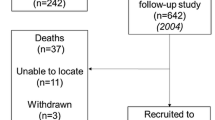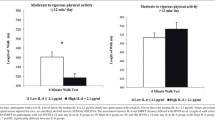Abstract
Sarcopenia has been associated with systemic inflammation and a range of other biological risk factors. The purpose of this study was to assess the systemic inflammation–muscle strength relationship in a large representative community-based cohort of older adults, and to determine the independence of this association from other biological and psychosocial risk factors. Participants were 1,926 men and 2,260 women (aged 65.3 ± 9.0 years) from the English Longitudinal Study of Ageing, a study of community dwelling older adults. We assessed hand grip strength and lower body strength (time required to complete five chair stands). Biological measures included C-reactive protein (CRP), fibrinogen, cholesterol, haemoglobin, glycated haemoglobin, adiposity, and blood pressure. Approximately 33% of the sample demonstrated elevated concentrations (≥3 mg/L) of CRP. After adjustments for age, smoking, physical activity, education, inflammatory diseases, and all other biological factors, elevated CRP was associated with poorer hand grip strength and chair stand performance in women but only chair stand performance in men. Low haemoglobin levels were consistently associated with poorer performance on both tests in women and men. These results confirm an independent association between low grade systemic inflammation (as indexed by CRP) and muscle strength that appears to be more robust in women.
Similar content being viewed by others
References
Andersen H, Nielsen S, Mogensen CE, Jakobsen J (2004) Muscle strength in type 2 diabetes. Diabetes 53:1543–1548. doi:10.2337/diabetes.53.6.1543
Brooks N, Layne JE, Gordon PL, Roubenoff R, Nelson ME, Castaneda-Sceppa C (2006) Strength training improves muscle quality and insulin sensitivity in Hispanic older adults with type 2 diabetes. Int J Med Sci 18:19–27
Cesari M, Pahor M (2008) Target population for clinical trials on sarcopenia. J Nutr Health Aging 12:470–478. doi:10.1007/BF02982708
Cesari M, Kritchevsky SB, Baumgartner RN, Atkinson HH, Penninx BW, Lenchik L, Palla SL, Ambrosius WT, Tracy RP, Pahor M (2005) Sarcopenia, obesity, and inflammation–results from the Trial of Angiotensin Converting Enzyme Inhibition and Novel Cardiovascular Risk Factors study. Am J Clin Nutr 82:428–434
Cesari M, Penninx BW, Lauretani F, Russo CR, Carter C, Bandinelli S, Atkinson H, Onder G, Pahor M, Ferrucci L (2004) Hemoglobin levels and skeletal muscle: results from the InCHIANTI study. J Gerontol A Biol Sci Med Sci 59:249–254
Charters Y, Grimble RF (1989) Effect of recombinant human tumour necrosis factor alpha on protein synthesis in liver, skeletal muscle and skin of rats. Biochem J 258:493–497
De Benedetti F, Alonzi T, Moretta A, Lazzaro D, Costa P, Poli V, Martini A, Ciliberto G, Fattori E (1997) Interleukin 6 causes growth impairment in transgenic mice through a decrease in insulin-like growth factor-I. A model for stunted growth in children with chronic inflammation. J Clin Invest 99:643–650. doi:10.1172/JCI119207
Ferrucci L, Penninx BW, Volpato S, Harris TB, Bandeen-Roche K, Balfour J, Leveille SG, Fried LP, Md JM (2002) Change in muscle strength explains accelerated decline of physical function in older women with high interleukin-6 serum levels. J Am Geriatr Soc 50:1947–1954. doi:10.1046/j.1532-5415.2002.50605.x
Gale CR, Martyn CN, Cooper C, Sayer AA (2007) Grip strength, body composition and mortality. Int J Epidemiol 36:228–235. doi:10.1093/ije/dyl224
Garcia-Martinez C, Lopez-Soriano FJ, Argiles JM (1993) Acute treatment with tumor necrosis factor induces changes in protein metabolism in rat skeletal muscle. Mol Cell Biochem 125:11–18. doi:10.1007/BF00926829
Graig R, Deverill C, Pickering K (2006) Quality control of blood, saliva and urine analytes. In: Spronston K, Mindell J (eds) Health survey for England 2004, Methodology and documentation, vol 2. The Information Centre, London, pp 34–41
Hamer M (2007) The relative influences of fitness and fatness on inflammatory factors. Prev Med 44:3–11. doi:10.1016/j.ypmed.2006.09.005
Kohut ML, McCann DA, Russell DW, Konopka DN, Cunnick JE, Franke WD, Castillo MC, Reighard AE, Vanderah E (2006) Aerobic exercise, but not flexibility/ resistance exercise, reduces serum IL-18, CRP, and IL-6 independent of beta-blockers, BMI, and psychosocial factors in older adults. Brain Behav Immun 20:201–209. doi:10.1016/j.bbi.2005.12.002
Landers KA, Hunter GR, Wetzstein CJ, Bamman MM, Weinsier RL (2001) The interrelationship among muscle mass, strength, and the ability to perform physical tasks of daily living in younger and older women. J Gerontol A Biol Sci Med Sci 56:M443–M448
Lang IA, Guralnik JM, Melzer D (2007) Physical activity in middle-aged adults reduces risks of functional impairment independent of its effect on weight. J Am Geriatr Soc 55:1836–1841. doi:10.1111/j.1532-5415.2007.01426.x
Newman AB, Kupelian V, Visser M, Simonsick EM, Goodpaster BH, Kritchevsky SB, Tylavsky FA, Rubin SM, Harris TB (2006) Strength, but not muscle mass, is associated with mortality in the health, aging and body composition study cohort. J Gerontol A Biol Sci Med Sci 61:72–77
Park SW, Goodpaster BH, Strotmeyer ES, Kuller LH, Broudeau R, Kammerer C, de Rekeneire N, Harris TB, Schwartz AV, Tylavsky FA, Cho YW, Newman AB (2007) Health, aging, and body composition study. Accelerated loss of skeletal muscle strength in older adults with type 2 diabetes: the health, aging, and body composition study. Diabetes Care 30:1507–1512. doi:10.2337/dc06-2537
Pearson TA, Mensah GA, Alexander RW, Anderson JL, Cannon RO 3rd, Criqui M (2003) Centers for Disease Control and Prevention, American Heart Association. Markers of inflammation and cardiovascular disease: application to clinical and public health practice: a statement for healthcare professionals from the Centers for Disease Control and Prevention and the American Heart Association. Circulation 107:499–511. doi:10.1161/01.CIR.0000052939.59093.45
Penninx BW, Pahor M, Cesari M, Corsi AM, Woodman RC, Bandinelli S, Guralnik JM, Ferrucci L (2004) Anemia is associated with disability and decreased physical performance and muscle strength in the elderly. J Am Geriatr Soc 52:719–724. doi:10.1111/j.1532-5415.2004.52208.x
Rantanen T, Harris T, Leveille SG, Visser M, Foley D, Masaki K, Guralnik JM (2000) Muscle strength and body mass index as long-term predictors of mortality in initially healthy men. J Gerontol A Biol Sci Med Sci 55:M168–M173
Ruiz JR, Sui X, Lobelo F, Morrow JR Jr, Jackson AW, Sjöström M, Blair SN (2008) Association between muscular strength and mortality in men: prospective cohort study. BMJ 337:a439. doi:10.1136/bmj.a439
Salive ME, Cornoni-Huntley J, Guralnik JM, Phillips CL, Wallace RB, Ostfeld AM, Cohen HJ (1992) Anemia and hemoglobin levels in older persons: relationship with age, gender, and health status. J Am Geriatr Soc 40:489–496
Schaap LA, Pluijm SM, Deeg DJ, Visser M (2006) Inflammatory markers and loss of muscle mass (sarcopenia) and strength. Am J Med 119:526 e9–526 e17
Stewart LK, Flynn MG, Campbell WW, Craig BA, Robinson JP, Timmerman KL, McFarlin BK, Coen PM, Talbert E (2007) The influence of exercise training on inflammatory cytokines and C-reactive protein. Med Sci Sports Exerc 39:1714–1719. doi:10.1249/mss.0b013e31811ece1c
Taaffe DR, Harris TB, Ferrucci L, Rowe J, Seeman TE (2000) Cross-sectional and prospective relationships of interleukin-6 and C-reactive protein with physical performance in elderly persons: MacArthur studies of successful aging. J Gerontol A Biol Sci Med Sci 55:M709–M715
Visser M, Pahor M, Taaffe DR, Goodpaster BH, Simonsick EM, Newman AB, Nevitt M, Harris TB (2002) Relationship of interleukin-6 and tumor necrosis factor-alpha with muscle mass and muscle strength in elderly men and women: the Health ABC Study. J Gerontol A Biol Sci Med Sci 57:M326–M332
Acknowledgements
M.H. is funded by the British Heart Foundation, UK. The data were made available through the UK Data Archive. The English Longitudinal Study of Ageing (ELSA) was developed by a team of researchers based at University College London, the Institute of Fiscal Studies and the National Centre for Social Research. Funding is provided by the National Institute on Aging in the United States (grants 2RO1AG7644-01A1 and 2RO1AG017644) and a consortium of UK government departments coordinated by the Office for National Statistics. The funders had no role in the study design; in the collection, analysis and interpretation of data; in writing of the report; or in the decision to submit the paper for publication. The developers and funders of ELSA and the Archive bear no responsibility for the analyses or interpretations presented here.
Author information
Authors and Affiliations
Corresponding author
About this article
Cite this article
Hamer, M., Molloy, G.J. Association of C-reactive protein and muscle strength in the English Longitudinal Study of Ageing. AGE 31, 171–177 (2009). https://doi.org/10.1007/s11357-009-9097-0
Received:
Accepted:
Published:
Issue Date:
DOI: https://doi.org/10.1007/s11357-009-9097-0




